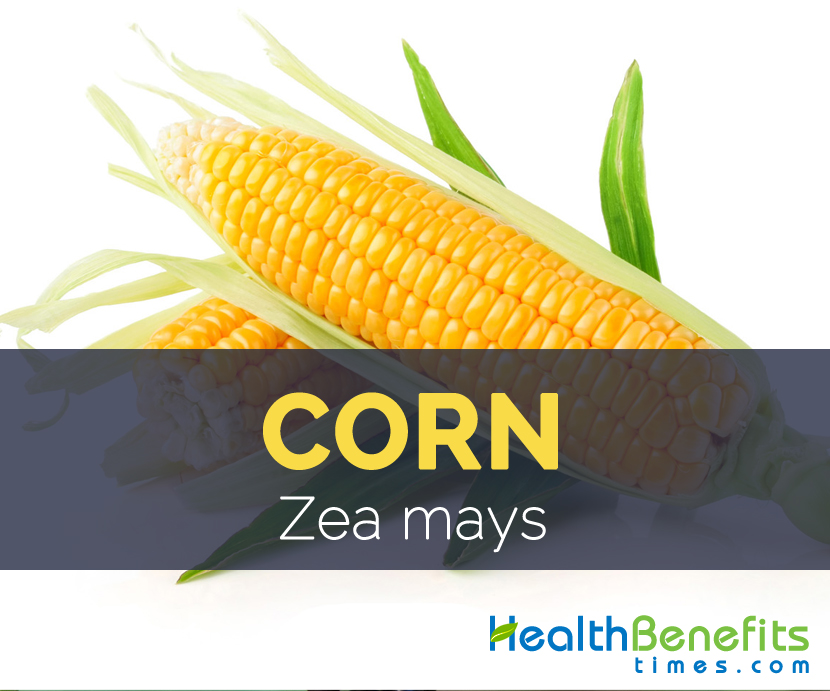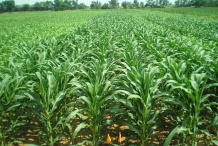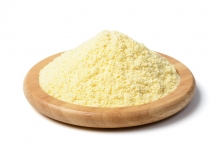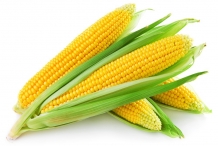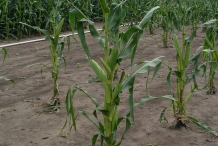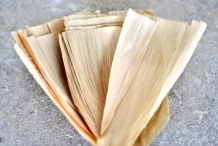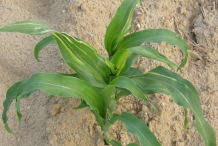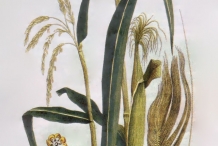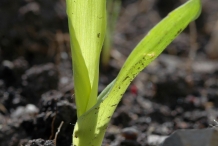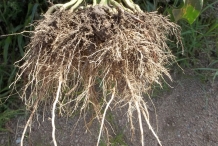Plant
Corn is tall monoecious annual grass sized 3 m (10 ft.) in height is found growing in tropical and subtropical regions around the world. Normally it prefers well drained, well-aerated, deep soils that contain sufficient organic matter and well supplied with other nutrients. Corn has rough fibrous root system that spreads widely and penetrates deeply and single erect stem made up of nodes and internodes, stem is commonly composed of 20 internodes of 18 cm (7.1 in) length. Leaves are alternate, with broad, sword-shaped leaf blades, parallel veins. Upper surface is hairy, lower surface hairless 50–100 cm long by 3–7 cm wide. Corn plant has separate male and female flowers on the same plant. On the branches, only female organs (called ears) develop in the florets while the male part of the flower (the tassel) produces pollen and is at the top of the plant.
Fruit
Even though considered as a vegetable, it is in reality a food grain. The leafy stalk of the plant provides ears that have the grains known as kernels. For each kernel on the cob, there exists a strand of silk. The white and yellow kernels are most widely used, however nowadays corn can be found in blackish, bluish-gray, purple, green, red, white and yellow depending on the varieties. Pericarp and testa are fused to form the fruit wall. Fruit also called kernel or grain and seed. An ear commonly holds 800 kernels in 16 rows. Apart from its delightful taste, it is found used in numerous food items around the world.
History
Maize is considered to have originated from Mesoamerica, probably in the Mexican highlands from where it spread. Different Archaelogical data and phylogenetic investigation recommended that domestication of maize in Mexico began at least 6,000 years ago (Piperno and Flannery 2001). Maize was spread around the world after the European discovery of the Americas in the fifteenth century. It is now cultivated worldwide. Maize is only known in cultivation and its exact genealogy remains unclear.
Nutritional Value
Apart from their distinctive moderate taste Corn is a good source of nutrients, vitamins and minerals.Consuming 145 gram of corn offers 27.12 g of Carbohydrate, 1.04 mg of Vitamin B5, 0.225 mg of Vitamin B1, 129 mg of Phosphorus, 2.566 mg of Vitamin B3 and 61 µg of Vitamin B9. Moreover many Amino acids like 0.033 g of Tryptophan, 0.187 g of Threonine, 0.187 g of Isoleucine, 0.505 g of Leucine, 0.199 g of Lysine and 0.097 g of Methionine are also found in 145 gram of the Corn.
Health benefits of Corn
Corn is quite popular food grain due to its delightful taste as well as wide range of nutrients. Corn offers several health benefits because of the existence of top quality nutrition within. Besides being a delightful addition to any meal, it’s also abundant with phytochemicals; also it offers protection against numerous long-term diseases. Some of the well-researched and widespread health advantages of corn are highlighted below.
1. Controls diabetes and hypertension
World seemed to suffer from an epidemic of diabetes in recent decades. Though the exact mechanism for this cannot be identified, it is usually supposed to relate to nutrition. Consumption of more organic fruits and vegetables, like corn, has been supposed to be a return to an older style of diet, and it has been related to reduce signs of diabetes. Studies have revealed that the consumption of corn kernels assists in the management of non-insulin dependent diabetes mellitus (NIDDM) and is effective against hypertension due to the occurrence of phenolic phytochemicals in whole corn. Phytochemicals can regulate the absorption and release of insulin in the body, which can decrease the coincidental of spikes and drops for diabetic patients and help them maintain a more normal lifestyle.(1), (2)
2. Lowers LDL Cholesterol
According to the Journal of Nutritional Biochemistry, consumption of corn husk oil lowers plasma LDL cholesterol by reducing cholesterol absorption within the body. As stated prior, this reduction of LDL cholesterol does not mean a reduction in HDL cholesterol, which is considered “good cholesterol” and can have a variety of helpful effects on the body, including the decrease of heart disease, avoidance of atherosclerosis, and a general scavenger of free radicals all through the body.(3), (4)
3. Beauty benefits
Corn starch is found used in the manufacturing of several cosmetic products and may also be used topically to calm skin rashes as well as irritation. Corn products are used to substitute carcinogenic petroleum products that are main constituents of several cosmetic preparations. Most of the traditional skin creams consists of petroleum jelly as a base material that can frequently block pores and make skin conditions even worse.(5)
4. Prevents Anemia
Anemia is caused due to deficiency of vitamins which is healed by the use of corn. Corn also has a substantial level of iron, which is one of the crucial minerals required to form new red blood cells; a deficiency in iron is also one of the chief reason of anemia as well.(6)
5. Rich source of calories
Corn is a rich source of calories and is a staple among dietary habits in many inhabitants. The calorific content of corn is 342 calories per 100 grams, which is among the highest for cereals. That’s why corn is frequently used for quick weight gain, and combined with the ease and flexibility of growing conditions for corn; the high calorie content makes it vital for the survival of dozens of agricultural-based nations.(7)
https://www.youtube.com/watch?v=qWg4z7_6y3A
How to Eat
- Young, immature cobs of the sweet corn type are used as vegetable.
- Young female inflorescences are enjoyed as a decorative vegetable in stir fries or salad in Western countries and in Asia.
- Sweet corn kernels are boiled or steamed and often used as a pizza topping, in salads or garnishes.
- Raw unripe kernels may also be shaved off the cobs and processed into a variety of cooked dishes, such as maize purée, curau, tamales, ice creams, pamonhas, cakes etc.
- Corn on the cob is a sweet corn cob that has been boiled, steamed, or grilled whole; the kernels are then eaten directly off the cob or cut off.
- Creamed corn is sweet corn kernels served in a milk or cream sauce or in soups.
- In Mexico, immature corn smut galls are relished as an edible delicacy known as cuitlacoche.
- Roasted dried maize cobs with complete semi-hardened kernels, coated with a seasoning mixture of fried chopped spring onions with salt added to the oil, is a prevalent snack food in Vietnam.
- Another very common type of corn is popcorn which bursts when heated into puffed, fluffy corn that is a popular snack food consumed all over the world.
- Cancha a homemade Andean snack consists of toasted corn kernels which pop without puffing and is made from a special large grained corn called maize chulpe.
- Dried maize kernels are also processed into hominy or nixtamal or by soaking and cooking in an alkali solution generally lime and hulled.
- Canjica a popular Brazilian dessert is made by boiling maize kernels in sweetened milk.
- Tepache, maize beer also known as chichi, is a light refreshing beer, made from maize kernels and is consumed throughout Mexico.
- Chicha a fermented and alcoholic drink and chichi morada (purple chicha) a soft drink are made from special varieties of maize and consumed in Peru.
- Bourbon whisky is made from purée that contains more than 51% of corn.
- Corn flakes made from milled corn is widely consumed as a crispy breakfast cereal, prevalent in North America and the United Kingdom, and in many other countries all over the world.
- Maize meal (ground dried maize) is made into numerous types of porridge or cooked corn meals in various cultures such as polenta in Italy, meali pap in south Africa, mămăligă (porridge of yellow corn) of Romania, sadza , nshima and ugali in other parts of Africa, angu in Brazil, hominy in southeastern USA or cornmeal mush in other parts of USA.
- Maize dough or corn flour is used as a replacement for wheat flour, to make cornbread as well as other baked products.
- An unleavened corn bread called makki di roti is prevalent bread consumed in the Punjab region of India and Pakistan.
- Masa or corn dough is made from newly prepared hominy, and is used for making corn tortillas, tostadas, tamales, atole, pupusas, pozole, arepas, pinole, and many other Latin American dishes.
- Corn starch is extensively used for a number of purposes in cooking, as in the making of desserts and the thickening of soups and gravy.
- Maize is also a major source of cooking oil and of maize gluten.
Other Facts
- Corn oil besides being edible is also used in the manufacture of soaps and paints.
- Starch from maize can also be made into adhesives, fabrics, plastics and many other chemical products.
- Corn starch is also used widely for laundry purposes.
- A sticky gum containing dextrin is used for sealing envelops, as well as on gummed labels.
- Corn is used for making alcohol.
- Cobs are used to supply potash, and by distillation they can be made to produce acetic acid and acetone.
- Maize meal is an important component of some commercial animal food products, such as dog food.
- In industrialized countries corn is used for animal feed, directly in the form of grain and forage, fodder, silage.
- Numerous aerial parts of the corn plant can be used for ethanol biofuel production.
- Corncobs can be hollowed out and treated to make cheap smoking pipes.
- Brown dye can be obtained from the cob.
- Sheaths of the cob are used for matting and paper making and as wrappers for cigarettes in parts of America and ceroots in Myanmar.
- Dry corn stalks are used to build fences.
- Maize kernels and cobs are also used as a biomass fuel source and is comparatively cheap and home-heating furnaces have been developed which use maize kernels as a fuel.
- Maize is used as a fish bait, called “dough balls”.
- Maize kernels are used in place of sand in a sandboxlike enclosure for kid’s play.
Corn – Zea mays Facts
Corn, also referred to as maize, is actually a huge grain plant that is believed to have originated from Mexico as well as Central America. Even though considered as a vegetable, it is in reality a food grain. It is found growing in well-aerated, deep soils containing sufficient organic matter and well supplied with important nutrients. It is nutrients dense grain food and offers protection against several long-term diseases.
| Corn Quick Facts | |
|---|---|
| Name: | Corn |
| Scientific Name: | Zea mays |
| Origin | Mesoamerica, probably in the Mexican highlands |
| Colors | Blackish, bluish-gray, purple, green, red, white and yellow |
| Shapes | long cylindrical |
| Calories | 125 Kcal./cup |
| Major nutrients | Carbohydrate (20.86%) Vitamin B5 (20.80%) Vitamin B1 (18.75%) Phosphorus (18.43%) Vitamin B3 (16.04%) |
| Health benefits | Controls diabetes and hypertension, Lowers LDL Cholesterol, Beauty benefits, Prevents Anemia, Rich source of calories |
| Name | Corn |
|---|---|
| Scientific Name | Zea mays |
| Native | Native to Mesoamerica, probably in the Mexican highlands |
| Common/English Name | Blue Corn, Annual Teosinte, Corn, Cultivated Maize, Pop Corn, Field Corn, Indian Corn, Maize, Turkish Wheat, Mealie, Sweet Corn, Turkish Corn, Grain Maize |
| Name in Other Languages | Czech : Kukurice Cukrová Amharic : Bäqqollo Burmese : Pyaung-Bu Zapotec : Lox Yela’ (Silk Immature Cob) Armenia n: Egipitacoren German : Echter Mais, Körnermais Azerbiajani : Gargy Daly French Haiti : Mayi ( Creole ) Croatian : Kukuruz Hungarian : Csemegekukorica Gambia : Many s Belarusian : Cucuruz Ghana : Kroju (Adangme-Krobo) Isle On Man : Praase ( Gaelic ) Guinea – Bissau : Ntubanyo ( Biafada ) Chechen : Hwaechk’a Benin : Bérétobourou Kiribati : Kaon Cook Islands : Kōni Khmer : Pôôt Brazil : Cabelo-De- Milho Finnish : Maissi Kenya : Mbembe ( Kikuyu ) Farsi : Awâri ( Eastern ) Lithuanian : Daržo Kukurūzai Irish : Arbhar Indiach Danish : Majs Indonesia : Jajong Latvian : Cucurkukurūza Georgian : Simindi Uyghur : Qonaq Polish : Kukurydza Cukrowa Luxembourg : Mais Angola : Espiga De Milho Democratic Republic Of Congo : Masasi( Kikongo ) Japanese : Fiirudo Koon Italian : Formentone Espernato : Maizo China : Sok Mai Fiji : Corn Bosnian : Kukuruz Kurdish : Gēnmēsāmi Tongan : Koane Guinea : Tubanyo ( Badyara ) Icelandic : Mais Kazakh : Sacharnaja Kukuruza Scottish : Cruithneachd ( Gaelic ) Portuguese : Milho Kirghizstan : Jügörü Aztec : Cintli French : Blé D’egypte Dutch : Korrelmaïs Comoros : Ndérou Laotian: Khauz Ph’ô:D Spanish : Cabellitos De Elote (Silk Of Immature Cob) Maltese : Qamh Ir-Rum Burkina Faso : Magno, Kaba ( Bambara ) Greek : Glyko Kalampoki Hebrew : Tiras Breton : Ed-Turki Morocco : Drâ Korean : Ok Soo Soo Rwanda : Ibigori Seychelles : Maïs Liberia : Gbu ( Basa ) Nigeria : Ansam ( Agoi ) Samoan : Fiso Huasa : Àgwààdóó India : Bhutta Ukrainian : Cukrova Kukurudza Hmong Daw : Pob Kws Nepal : Makai Bulgaria : Carevica Kamba : Mbemba Sierra Leone : Kã Romanian : Porumb West Cameroons : Ngui ( Bafok ) Mali : Kaba ( Bambara ) Senegal : Ekôntibaba Galician : Mainzo Burundi : Ikigori ( Kirundi ) Kashmiri : Dŏda-Hĕdur Madagascar : Somo-Katsaka Slovencina : Kukurica Siata Mauritius : Maïs Tasengart: ( Berber ) Nicobar Islands : Peòk ( Car ) Persian : Bajri Thai : Khaophot Philippines : Mais ( Bisaya ) Russian : Kukuruza Niger : Kòtòkòalí ( Dendi ) Swedish : Majs Macedonian : Slatka Pčenka Shona : Bonore Vietnamese : Ngô Togo : Bli ( Ewé ) Niuean : Ahi Sotho : Mahea Yiddish : Kukuruzeh Turkish : Kokoroz Malaysia : Jagung Catalan : De Blat De Moro Sudan : Manio ( Bambara ) Tajikistan : Juvorimakka Tanzania : Dana Mongolian : Erdene Shish Uzbek : Makkajo’xori Zulu : Mbila Tibetan : Āshom Sorbian : Kukurica Eastonian : Lõhenev Mais Tongan : Cingoma South Africa : Mafela Swahili : Mahindi Norwegian : Mais Turkmen : Mekgejöwen Uganda : Duma Serbian : Kukuruz Welsh : Corn Melys Albanian : Misër I Ëmbël |
| Plant Growth Habit | Tall, monoecious annual grass |
| Growing Climate | Cultivated in tropical and subtropical regions |
| Soil | Well drained, well-aerated, deep soils containing adequate organic matter and well supplied with nutrients. |
| Plant Size | 3 m (10 ft) in height |
| Root | Coarse fibrous root system that spreads widely and penetrates deeply, |
| Stem | Single erect stem made up of nodes and internodes, stem is commonly composed of 20 internodes of 18 cm (7.1 in) length. |
| Leaf | Alternate, with broad, sword-shaped leaf blades, parallel veins. Upper surface is hairy, lower surface hairless 50–100 cm long by 3–7 cm wide |
| Flower | The male and female flowers are separated but on the same plant. On the branches, only female organs (called ears) develop in the florets while the male part of the flower (the tassel) produces pollen and is at the top of the plant. |
| Fruit Shape & Size | Long, cylindrical |
| Fruit Color | Blackish, bluish-gray, purple, green, red, white and yellow |
| Varieties/Types | Dent maize, flint maize, Floury maize, Waxy maize, Pop maize, Sweet maize, Japanese striped maize, Blue corn, Ottofile, Pignoletto, Nostrano Dell’Isola |
| Major Nutrition | Carbohydrate 27.12 g (20.86%) Vitamin B5 (Pantothenic acid) 1.04 mg (20.80%) Vitamin B1 (Thiamin) 0.225 mg (18.75%) Phosphorus, P 129 mg (18.43%) Vitamin B3 (Niacin) 2.566 mg (16.04%) Vitamin B9 (Folate) 61 µg (15.25%) Leucine 0.505 g (13.66%) Magnesium, Mg 54 mg (12.86%) Valine 0.268 g (12.69%) Isoleucine 0.187 g (11.18%) Vitamin C (Ascorbic acid) 9.9 mg (11.00%) Threonine 0.187 g (10.63%) Histidine 0.129 g (10.47%) Vitamin B6 (Pyridoxine) 0.135 mg (10.38%) Manganese, Mn 0.236 mg (10.26%) |
| Health Benefits |
|
| Calories in 1cup (100gm) | 125 Kcal |
References:
http://www.ibaf.cnr.it/phytoremediation/zea-mays-heavy-metals-organic-contaminants.pdf


